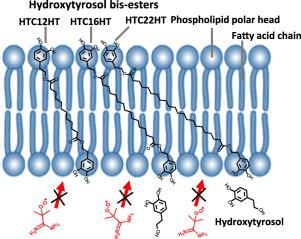Biochimica et Biophysica Acta (BBA) - Biomembranes ( IF 2.8 ) Pub Date : 2020-12-03 , DOI: 10.1016/j.bbamem.2020.183505 Rafaela Lopes , Marlene Costa , Mariana Ferreira , Paula Gameiro , Fátima Paiva-Martins

|
Hydroxytyrosol (HT) is a well-known olive oil polyphenol for its high antioxidant capacity and important cardio and neuroprotective effects. However, its use in lipidic systems is limited, due to its hydrophilic character. In this study, we approach the particular structure of xanthophylls and synthetize HT esters specially designed for the protection of liposomal systems. These HT esters contain two polyphenolic moieties separated by a lipophilic alkyl spacer of different length (12, 16 or 22 carbons). To evaluate the antioxidant activity of these compounds against the 2,2′-azobis(2-amidinopropane) hydrochloride induced oxidation, soybean phospholipid liposomes were used. Fluorescence quenching studies were used to assess the insertion of the compounds in the liposomes. The synthetized HT derivatives were able to protect liposomes from induced oxidation when added to the suspensions. The rank of activity was severely influenced by the alkyl chain length of the spacer molecule, being the C12 derivative the most active antioxidant, with an increase in the oxidative stability of liposomes of 2.2 times when compared with the control. The incorporation of compounds during liposome preparation improved the antioxidant capacity of all HT derivatives by about 2.8 times, when compared to the control. This is probably due to a similar transmembrane position with both polyphenolic rings located at the phospholipid polar heads. The synthesis of bis-ester derivatives seems to be a promising strategy to fine-tune antioxidant molecules at biomembranes, thus increasing the oxidative stability of liposomal systems by improving the antioxidant activity of hydrophilic phenolic compounds with high free radical scavenging activity.
中文翻译:

羟基酪醇酚脂的新家族,用于脂质体系统的抗氧化保护
羟基酪醇(HT)是一种众所周知的橄榄油多酚,具有很高的抗氧化能力以及重要的心脏和神经保护作用。然而,由于其亲水性,其在脂质体系中的使用受到限制。在这项研究中,我们研究了叶黄素的特殊结构并合成了专为保护脂质体系统而设计的HT酯。这些HT酯包含两个多酚部分,其被不同长度(12、16或22个碳)的亲脂性烷基间隔物隔开。为了评估这些化合物对2,2'-偶氮双(2-ami基丙烷)盐酸盐诱导的氧化的抗氧化活性,使用了大豆磷脂脂质体。荧光猝灭研究用于评估化合物在脂质体中的插入。当添加到悬浮液中时,合成的HT衍生物能够保护脂质体免受诱导的氧化。活性等级受到间隔物分子的烷基链长度的严重影响,间隔物分子是最活跃的抗氧化剂C12衍生物,与对照相比,脂质体的氧化稳定性提高了2.2倍。与对照相比,脂质体制备过程中化合物的掺入将所有HT衍生物的抗氧化能力提高了约2.8倍。这可能是由于两个多酚环都位于磷脂极性头上时跨膜位置相似。双酯衍生物的合成似乎是微调生物膜抗氧化剂分子的一种有前途的策略,











































 京公网安备 11010802027423号
京公网安备 11010802027423号